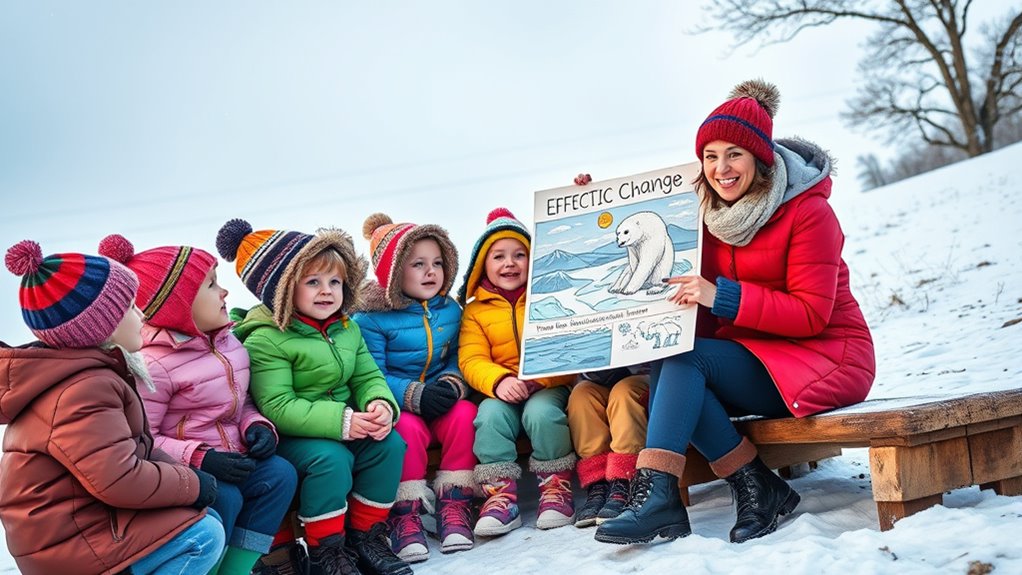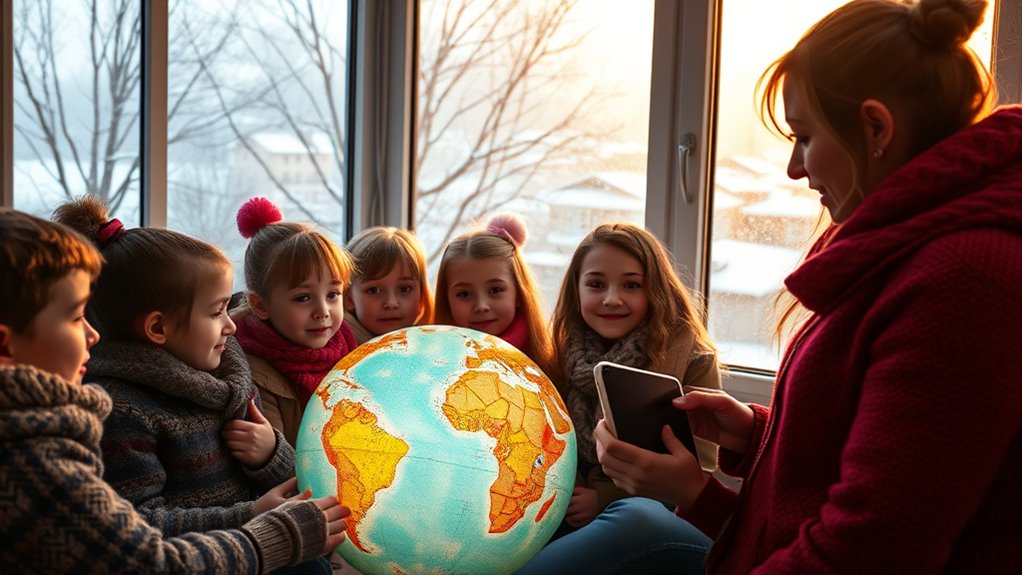Teaching kids about climate change in winter can be engaging by connecting seasonal changes to environmental impacts. Use outdoor activities like observing snow, ice melting, or wildlife adaptations to illustrate climate concepts. Talk about renewable energy sources like wind turbines and solar panels, even during winter storms. Encourage energy-saving habits and conservation tips suited for colder months. Continuing to explore these ideas will help you find simple, effective ways to inspire ongoing climate awareness and responsibility in children.
Key Takeaways
- Use winter visuals like snow and ice to demonstrate climate change impacts and seasonal differences.
- Connect outdoor winter activities to broader climate concepts, such as renewable energy supporting communities during storms.
- Teach conservation tips like turning off lights and unplugging electronics to promote energy savings in winter.
- Explain how renewable energy sources function year-round, even in winter, to reduce carbon footprints.
- Encourage ongoing environmental responsibility through winter reflections, linking seasonal changes to long-term climate action.

Winter might seem like an unlikely time to talk about climate change, but it’s actually an excellent opportunity to engage kids in meaningful conversations about our planet. During these colder months, you can highlight the importance of renewable energy sources like wind and solar power, which help reduce greenhouse gas emissions no matter the season. Explaining how renewable energy works can be both fun and educational—for example, you might show your kids pictures of solar panels or wind turbines and discuss how they produce clean electricity. This helps them understand that sustainable energy isn’t just a summer project; it’s a year-round solution to climate change.
Winter also provides a perfect chance to teach conservation tips that can make a real difference. You can encourage your kids to turn off lights when they leave a room, unplug electronics not in use, and dress warmly to avoid cranking up the heater unnecessarily. These small actions add up, and when kids see how simple changes can save energy, they become more conscious of their habits. You might also explore ways to conserve water and reduce waste, like using reusable bottles or recycling holiday packaging. Sharing these tips makes conservation feel practical and achievable, especially during the season of giving and sharing.
Encourage kids to save energy by turning off lights, unplugging devices, and dressing warmly this winter.
Talking about climate change during winter during contrast with summer can also involve outdoor activities that highlight the impact of our choices. For instance, you could take a walk in the snow and observe how local wildlife adapts or discuss how melting snow and ice are connected to rising global temperatures. These real-life examples make the abstract concept of climate change more tangible for kids. You can also explore how renewable energy can help communities during winter storms—like how wind turbines can generate power even when the sun isn’t shining or how energy-efficient heating reduces fuel consumption. Connecting these ideas helps children see the positive ways we can combat climate issues through innovative solutions.
Finally, winter’s quiet, reflective atmosphere can inspire conversations about the importance of caring for the environment all year long. Use this time to reinforce conservation tips and introduce ideas for sustainable living that kids can carry into spring and beyond. By framing winter as a season of learning and action, you empower your children to see themselves as part of the solution. Teaching about renewable energy and conservation during this time not only makes the topic relevant but also instills habits that can last a lifetime, shaping environmentally responsible adults who understand their power to make a difference.
Frequently Asked Questions
How Can I Explain Climate Change to Very Young Children?
You can explain climate change to young children using simple analogies, like comparing Earth to a blanket that keeps us warm. Use visual aids like pictures or drawings to show how pollution builds up and traps heat. Keep it fun and easy to understand, emphasizing that caring for our planet helps keep it healthy. This way, kids grasp the idea without feeling overwhelmed, and they learn how their actions matter.
What Are Fun Winter Activities to Teach Climate Concepts?
You can make learning about climate concepts fun with winter activities like ice skating and snowman building. While ice skating, explain how melting ice affects our planet’s temperatures, showing how climate change impacts winter sports. Building snowmen helps kids understand snow patterns and how warming temperatures can reduce snowfall. These engaging activities make climate ideas tangible, encouraging curiosity and awareness while enjoying winter weather together.
How Do I Address Climate Anxiety in Kids During Winter?
You can address climate anxiety in kids during winter by practicing mindful communication and offering emotional support. Encourage open conversations, listen without judgment, and validate their feelings. Help them understand that their concerns are valid while emphasizing positive actions they can take, like conserving energy or planting trees. This approach builds resilience, eases anxiety, and fosters hope, empowering children to feel more in control amid climate worries.
Are There Books Suitable for Teaching Climate Change in Winter?
Yes, there are great winter stories and climate books designed for kids. You can choose books that explain climate change through engaging winter-themed stories, making complex ideas more relatable. Look for titles that highlight how winter weather connects to climate health, encouraging curiosity and awareness. These climate books help children understand environmental issues while enjoying seasonal tales, fostering a sense of responsibility and empowerment during the winter months.
How Can I Involve Kids in Winter Eco-Friendly Habits?
You can involve kids in winter eco-friendly habits by encouraging recycling projects, like sorting recyclables or creating art from recycled materials. Teach them energy conservation by turning off unused lights, bundling up to reduce heating, and explaining how these actions help the planet. Make it fun with challenges or rewards, and involve them in planning eco-friendly activities. This hands-on approach helps kids understand their role in protecting the environment even during winter.
Conclusion
Remember, a little knowledge goes a long way. Winter might seem like a quiet time, but it’s the perfect opportunity to teach kids about climate change and inspire them to make a difference. As the saying goes, “The early bird catches the worm.” By starting these conversations now, you’re helping shape a future where kids understand and care for our planet, no matter the season. Every small step counts toward a healthier Earth.







